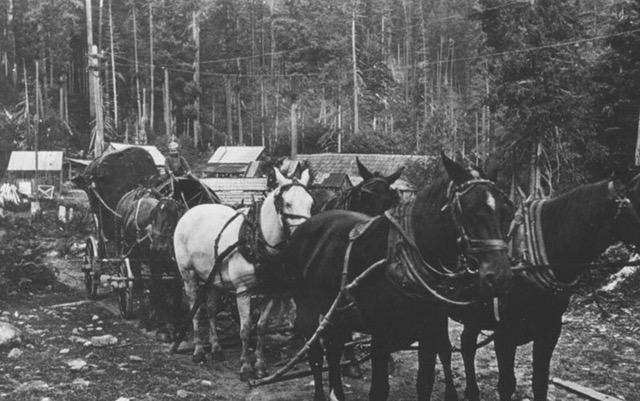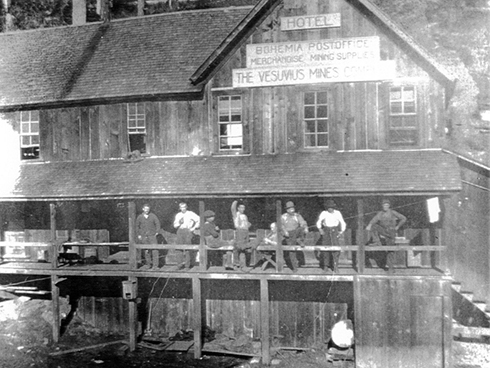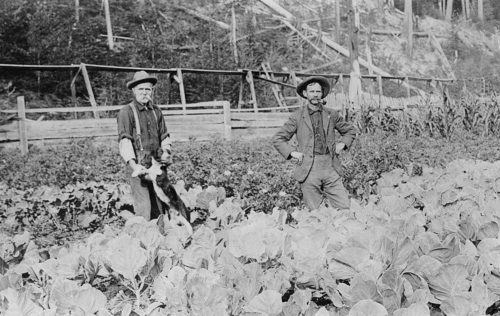Story by Katy Vaughn
 In 1858 a group of settlers found traces of placer gold in Sharp’s Creek, east of Cottage Grove. They later returned with a sluice box and got a small amount of gold. They gave up the endeavor not realizing that there were large amounts of gold, not in the creek beds, but further up the mountains under the ground.
In 1858 a group of settlers found traces of placer gold in Sharp’s Creek, east of Cottage Grove. They later returned with a sluice box and got a small amount of gold. They gave up the endeavor not realizing that there were large amounts of gold, not in the creek beds, but further up the mountains under the ground.
In the spring of 1863 James “Bohemia” Johnson fled Roseburg under suspicion of having killed an Indian. He and a companion, George Ramsey, followed Steamboat Creek into the Row River watershed. They killed a deer for food and while they were skinning it, they spotted gold-bearing quartz on the ground. Johnson and Ramsey spread the word around Cottage Grove and by 1864 prospectors were heading for the hills.
Soon more than 100 claims were staked, with the imaginative names that became a hallmark of the District. Amongst them were Venus and Mars, Paradise and Hellhole, Falling Star and Fallen Leaf, The Moor and The Hindoo, and Orphan Boy and Lucky Boy. By 1866 the beginnings of Bohemia City were in place. Within two years it had a hotel, a saloon, an assay office and a collection of miner’s cabins.
Also in 1866, the miners in the area established a code of laws which set the boundaries for the District and established several rules by which the miners were expected to operate. Included in the rules were claim sizes (100 by 25 yards) and claim limits of one per person and two to the original discoverer. It also provided for “town lots” in Bohemia City of 50 by 75 feet that had to have a cabin built on it, or a fence around, to be considered held by a miner.
The Knott Trail was built in 1871 and became the first road that allowed machinery and freight to be brought to the mines. The first stamp mill was brought in over this trail. An earlier trail came from Sutherlin, but the distance proved to be a hindrance to it becoming a main road. Interest in the mines waxed and waned until 1889 when the Annie mine and Musick mine were discovered and developed, a road was built through Mineral, and the Red Bridge was built along the Row River over Sharp’s Creek.
 Things really boomed in 1903 when the Oregon Securities Company assumed control of the Champion, Helena and Musick mines and the Oregon and Southeastern Railroad. A 30-stamp mill was constructed at the Champion mine, a 6,000 foot tramway was built, and power was brought in via the Warehouse at Lund Park. Freighting and passenger depots were built at Mineral and Lund Park, hotels were located at Mineral, Lund Park and Noonday Ridge, and horses could be freshened at the Painted Post Ranch on Sharp’s Creek. There was a large vegetable garden at the Warehouse and fresh beef was brought up to the mines on a regular basis by George and Carrie Layng who ranched near Rujada. During the boom years thousands of men worked the mines and millions of dollars worth of gold were taken out.
Things really boomed in 1903 when the Oregon Securities Company assumed control of the Champion, Helena and Musick mines and the Oregon and Southeastern Railroad. A 30-stamp mill was constructed at the Champion mine, a 6,000 foot tramway was built, and power was brought in via the Warehouse at Lund Park. Freighting and passenger depots were built at Mineral and Lund Park, hotels were located at Mineral, Lund Park and Noonday Ridge, and horses could be freshened at the Painted Post Ranch on Sharp’s Creek. There was a large vegetable garden at the Warehouse and fresh beef was brought up to the mines on a regular basis by George and Carrie Layng who ranched near Rujada. During the boom years thousands of men worked the mines and millions of dollars worth of gold were taken out.
In 1905 “high grade” was hit in the Champion Mine. It assayed at $30,000.00 per ton. According to a 1970 article in our book “Golden Was the Past” the ore was so valuable that only certain men were allowed in the excavation. Canvas was spread on the floor and the walls were brushed down on it. One man who saw some of the rock said it glittered like a jewelry store. It is said that some of the miners made more money than their wages by sifting ore into their tobacco pouches.
All of these single men coming into town on Saturday nights turned Cottage Grove into a wild and wooly old west town. There were plenty of bars and brothels ready to take their money. It was claimed that the mine owners preferred to hire men who could be counted on to spend their entire check over the weekend, because they knew that they would be back to work on Monday. The men who scrimped and saved would eventually leave to start their own businesses and would not be back to work the mines.
Mining started to decrease after 1915, and that year timber interests bought out the railroad that was meant to bring supplies and people to the mines (only the first 15 miles were built, the last 15 miles of track that would have reached the mines were never completed.)
In 1939 Higgins and Hinsdale leased the greater part of the mining district and began to extract gold, silver, lead, copper and zinc. This enterprise did not last long because when WWII broke out the issue of Order L28 closed down all mines that were not considered strategic, including the entire Bohemia Mining District. Much of the equipment in the District was salvaged for scrap metal for the War effort.
You can learn more about the Bohemia Mining District from these sources for this lesson.
https://www.bohemiagoldminingmuseum.com
https://bohemiamineownersassociation.webs.com/history.htm
You can order our, book Golden Was the Past here…
